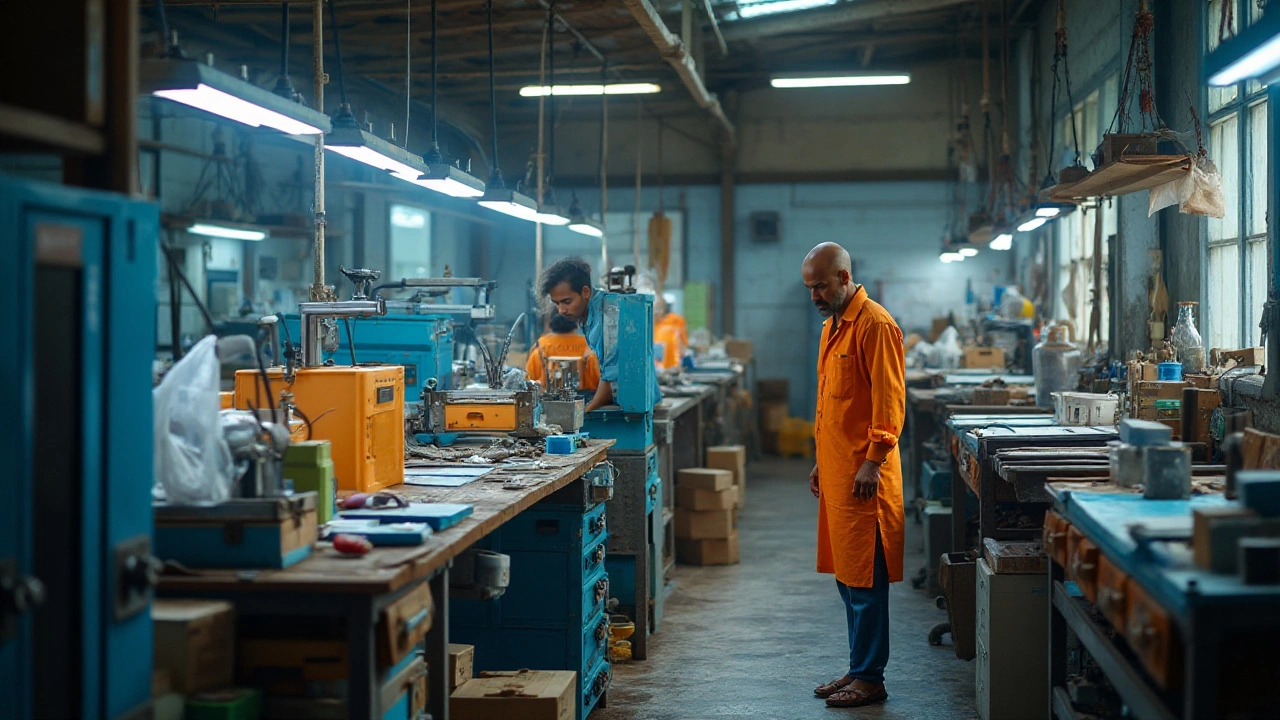Top Small-Scale Manufacturing Industries to Watch in 2024

The small-scale manufacturing sector is poised for a transformative year in 2024, with several industries expected to ride the waves of change. As technological innovation continues at a rapid pace and consumer awareness around sustainability grows, niche markets are emerging, bringing fresh business opportunities for those eager to dive in.
From crafting eco-friendly products to leveraging the power of smart technology in homes, there are industries that just might redefine entrepreneurship. Explore how personalized manufacturing, environmentally conscious production, and local artisan goods are reshaping economic landscapes, and consider the steps you might take to carve out your niche in this evolving market.
- Emergence of Eco-Friendly Products
- Rise of Custom 3D Printing
- Local Artisanal Goods
- Smart Home Gadgets Production
- Sustainable Packaging Solutions
- Tips for Entrepreneurs
Emergence of Eco-Friendly Products
In recent years, the demand for eco-friendly products has surged, proving this trend is more than just a passing fad. As awareness of environmental issues increases, consumers are increasingly opting for products that promise lower environmental impact and sustainable sourcing. This shift is prompting small-scale manufacturers to rethink their processes and products, encouraging a wave of innovation born out of necessity. Many entrepreneurs are finding new ways to source materials, design with recycling in mind, and incorporate biodegradable elements into everyday items.
The success stories are numerous. From biodegradable packaging materials made from mushrooms to innovative shoes crafted from recycled plastics fished out of the ocean, the market is wide open for those willing to prioritize the planet alongside profit. According to a 2023 survey by GlobalData, about 37% of consumers are willing to pay more for products labeled as sustainable, underscoring a critical market opportunity. Large corporations are not immune to this trend either. Small businesses can find ways to collaborate or incorporate these principles into their models, ensuring they are part of a growing movement rather than being left behind.
Eco-Friendly Manufacturing Processes
Transitioning to eco-friendly manufacturing methods is not just about using green materials. It involves innovation at every step of the production process. Businesses are increasingly looking at energy efficiency, waste reduction, and water conservation. For example, adopting upcycled materials reduces the need for raw resources and cuts costs significantly. Besides raw materials, the manufacturing methods have adjusted to incorporate more energy-efficient machinery and renewable energy sources wherever possible. As more governments provide incentives for businesses adopting green practices, the benefits are becoming too significant to ignore.
"The rise of eco-friendly products is not just a trend; it's a societal shift that we, as manufacturers, must adapt to," said Jean Rogers, chairperson of the Sustainability Accounting Standards Board.
Indeed, the path toward eco-friendly products was further emphasized during the COVID-19 pandemic, which forced many industries to reconsider their supply chains. The pursuit of local, sustainable sources has become part of risk management strategies, offering a more robust, ethical alternative. To support this shift, governments worldwide are likely to impose stricter regulations and incentives, such as tax breaks for sustainable business practices, making eco-friendly manufacturing not just a moral choice but an economically sound strategy.
Innovation in Eco-Product Design
Creativity and innovation are at the heart of sustainable product design. Companies are increasingly seeking to tailor their offerings to meet not only the demands of the environmentally conscious consumer but also those looking for unique and functional design. Bioplastics, compostable cutlery, and zero-waste packaging are examples of areas where creativity has led to practical solutions to everyday problems. One fascinating development is the use of algae as a material for producing not only biodegradable plastics but also textiles and packaging, thus broadening the horizons of what is possible in sustainable materials.
For small businesses, this means opportunities to not only develop their own eco-friendly lines but also collaborate with larger firms or tech startups that have the resources for advanced research and development. The room for partnership is vast, and by tapping into these resources, smaller entities can bring their products to market faster. As consumers lean more toward values of ethical consumption, the narrative around products has shifted as well. Storytelling in marketing, emphasizing a product's sustainable journey, has become an integral part of brand strategy, allowing companies to differentiate themselves in a crowded marketplace.
Rise of Custom 3D Printing
The evolution of 3D printing technology has been astounding, and 2024 is set to be a breakthrough year for custom 3D printing in small-scale manufacturing. The appeal of creating unique, tailored products has driven demand, and advances in technology mean that what was once a niche market is rapidly becoming mainstream. More businesses are investing in 3D printers, and as the costs decrease, accessibility is improving exponentially. This democratization of manufacturing enables companies to experiment with designs without the prohibitive costs associated with traditional prototyping.
3D printing allows for an unprecedented level of customization, making it ideal for sectors like healthcare, fashion, and automotive industries. For instance, in healthcare, the ability to produce bespoke prosthetics and dental implants tailored to individual patients can dramatically improve outcomes and reduce waiting times. Similarly, in fashion, designers can now create unique, one-off items that cater to an ever-growing market of consumers seeking individuality and personal expression through their clothing. The automotive industry is also benefiting, with customized car parts produced more efficiently than ever before, allowing car enthusiasts to personalize their vehicles to a degree previously unimaginable.
"The potential for 3D printing to revolutionize manufacturing is immense, as it not only reduces waste but also allows for greater flexibility in the design and production process," says Dr. Lisa Stephens, a leading expert in additive manufacturing.Beyond direct product creation, 3D printing is enhancing supply chain resilience. During disruptions, businesses with 3D printing capabilities can pivot faster by producing necessary components locally rather than waiting on global shipments. This agility can be critical in times of crisis or demand surges. Moreover, with an emphasis on sustainable practices, 3D printing can contribute by using fewer resources and minimizing waste compared to traditional manufacturing methods.
The Role of Innovation
The ongoing innovation in 3D printing materials is another driving factor in its rise. Researchers are constantly developing new materials that expand what can be printed, from biocompatible substances for medical applications to durable materials for construction. Recently, the introduction of recyclable filaments and biodegradable materials has aligned with the sustainable trend sweeping through various industries, making custom 3D printing a responsible choice for environmentally conscious businesses. As these materials evolve, expect to see new applications emerge, each opening up fresh market opportunities.
The accessibility of 3D printing technology is fostered by a strong culture of sharing and open-source developments. Platforms that allow designers and hobbyists to exchange ideas and designs freely add to the wealth of resources available to entrepreneurs entering this exciting field. From simple tools and toys to complex machinery parts, the possibilities are as varied as the imagination itself. This thriving ecosystem is supported by an array of tutorials and resources readily available online, enabling newcomers to gain expertise and hit the ground running.
Looking to the Future
As we look towards the future, the impact of 3D printing on the manufacturing landscape is undeniable. The technology is becoming more ingrained in educational curricula, equipping a new generation with skills crucial for future innovations. With advancements in speed and efficiency, 3D printing might soon be part of everyday consumer experiences, wherein people can customize and print products in stores or even from the comfort of their homes. Such shifts not only revolutionize business models but also redefine consumer expectations and interactions with products, offering an intimacy and immediacy never before possible.

Local Artisanal Goods
In an age where mass production and digitization often overshadow craftsmanship, the allure of local artisanal goods is experiencing a remarkable resurgence. This trend is as much about valuing the uniqueness and authenticity of handmade products as it is about fostering sustainable and community-based economies. Artisanal goods provide consumers with a personal connection to the maker, often telling a story that extends beyond the product itself. As we navigate through 2024, local artisanal products are set to capture the hearts and wallets of those yearning for something more meaningful in their purchases.
The demand for handcrafted items is growing, driven by consumers' desire for products that are not just functional but also aesthetically pleasing and emotionally resonant. This growing interest extends from home decor and fashion to food and beverages, where individuality and quality reign supreme. Artisanal producers are able to leverage their localized production methods to maintain a high standard and distinctive character in their offerings. Their markets include farmers' markets, online platforms dedicated to crafts, and boutique stores, each providing a unique opportunity for artisans to showcase their work. According to a study by the Handmade Goods Association, the artisanal sector is expected to grow by 15% annually over the next few years, signifying a strong consumer shift towards sustainable and handcrafted goods.
Artisanal production not only promotes cultural heritage but also bolsters local economies by creating jobs and sustaining skilled labor in communities. The closer relationship between craftsmen and consumers fosters a sense of trust and transparency, integral in a world rife with impersonal e-commerce giants. Consumers are keen to know more about where their products come from, who made them, and the ethos behind their creation. In this context, an artisanal producer can establish a loyal customer base by focusing on storytelling and authenticity.
"People want to feel a connection to what they buy," says artisan and entrepreneur Emma Jones. "They want to support real people, real stories, not just buy things," she adds, highlighting the tangible shift in consumer behavior.
The plight and promise of small-scale artisans this year lie in their ability to blend tradition with innovation. By incorporating new techniques and materials while preserving the essence of artisanal craft, businesses can expand their reach and appeal. This delicate balance is crucial for artisans looking to thrive in a competitive market. Small-scale manufacturing offers the flexibility to adapt quickly to trends while also experimenting with an array of designs and customizations tailored to consumer preferences. This agility can be a significant advantage over larger, more rigid production houses. As such, the artisanal goods industry is not only about preserving the past but is very much part of the future of local and sustainable business models.
Smart Home Gadgets Production
The smart home gadgets sector is rapidly expanding, driven by a mix of technological innovation and increasing consumer appetite for convenience and efficiency. As we moved through 2024, the industry saw an uptick in the demand for devices that not only automate daily tasks but also enhance the home environment through advanced connectivity. From smart thermostats that adjust the temperature on the fly to security systems that offer peace of mind through real-time alerts, these gadgets have become integral to modern living.
One of the most significant trends is the integration of Artificial Intelligence and machine learning into smart home gadgets. These technologies enable devices to learn user behaviors, tailoring their functions to individual preferences. For instance, smart lighting systems that adjust based on time of day, or even the routines of the residents, offer an almost invisible means of energy conservation. This adaptability not only adds a personalized touch to home automation but also cements the value of such gadgets beyond mere novelty.
In terms of environmental impact, smart home gadgets also make noteworthy contributions. Energy-efficient devices are now a major selling point, appealing to eco-conscious consumers eager to reduce their carbon footprint. For example, intelligent power strips and smart appliances help to monitor and optimize electricity usage, minimizing waste. According to a recent study, homes utilizing advanced automation technologies can reduce energy consumption by up to 30%, showcasing the significant cost savings potential for users.
Developing these smart devices involves not just technological prowess but also an understanding of user interface design that melds seamlessly with existing home aesthetics. Companies like Google and Amazon are deeply involved in research and development, striving to make their devices both intuitive and aesthetically pleasing. A report in TechCrunch highlighted, "The future of smart home technology focuses on creating not just functional tools, but aspirational products that align with personal values.”
The production of small-scale manufacturing smart home gadgets also provides a fertile ground for startups and smaller enterprises to innovate. By focusing on niche markets or unique functionalities, these companies can carve out a dedicated user base. Entrepreneurs exploring this space have the opportunity to address unmet consumer needs, from developing affordable voice-controlled automation for seniors to creating environmentally friendly gadgets using recyclable materials. This nuanced approach not only opens a pathway for differentiation but also aligns with current consumer trends driven by personalization and sustainability.
Looking at the growth patterns, it's evident that the smart home trend is more than just a passing phase. Data indicates a steady increase in smart home device adoption, with projections estimating a global market value of $208 billion by 2025. As more consumers embrace this lifestyle, driven by the convenience and efficiency it offers, small-scale manufacturers are uniquely positioned to contribute innovations that add value to everyday living. The future of smart home gadget production indeed holds promise, driven by an ambitious intersection of technology, sustainability, and user-centric design.

Sustainable Packaging Solutions
The demand for sustainable packaging solutions is on the rise, driven by an increasing global awareness of environmental issues and a collective push towards greener practices. Businesses, big and small, are seeking ways to minimize their ecological footprint, creating vast opportunities in the small-scale manufacturing sector. Consumers today aren't just looking for quality products; they're also interested in the environmental impact of their purchases, and packaging is a crucial part of this equation. From biodegradable materials to innovative reusable designs, packaging is as integral to an eco-friendly product as the product itself.
Traditional packaging materials such as plastic and non-recyclable composites have contributed significantly to landfill waste, becoming a pressing environmental concern. A growing number of companies are switching to alternatives like mushroom packaging, which uses agricultural waste bound together by fungal roots, or seaweed-based wraps that break down naturally. These innovations not only reduce waste but often offer unique packaging characteristics that appeal to environmentally conscious consumers. A shift like this doesn't happen overnight; it's part of a broader trend of 'reduce, reuse, and recycle' that savvy manufacturers are tapping into.
An essential aspect of this movement is the focus on reducing single-use packaging. Many manufacturers are investing in creating durable, reusable solutions that not only help cut down waste but also serve as a value addition to their product lines. Think multi-use container designs that fit a variety of purposes or items packaged in containers that double as a functional part of the product. Such ingenious packaging solutions do more than just address sustainability—they play a role in enhancing user experience.
Engaging with sustainable packaging requires a commitment not only to materials but also to the manufacturing processes. As more brands adopt clean energy sources for production, such as wind or solar power, the overall environmental impact is further diminished. This shift presents a fantastic opportunity for small-scale manufacturers to collaborate with eco-friendly startups to create packaging that speaks to the values of a modern, environmentally-aware consumer base.
According to the Smithers Pira report, the demand for sustainable packaging is expected to grow at 5.9% per year, indicating robust market interest.
With the global packaging landscape evolving, it's essential for manufacturers to stay informed and adaptive. Building partnerships with suppliers of sustainable raw materials, investing in research and development for innovative designs, and participating in industry forums are just a few ways companies can stay ahead of the curve. Moreover, transparent communication about the sustainable aspects of their packaging can build consumer trust and brand loyalty, which are invaluable in the cluttered marketplace.
Here is a glimpse of some sustainable materials and their potential applications in packaging:
| Material | Application | Properties |
|---|---|---|
| Bioplastics | Food and beverage packaging | Compostable and biodegradable |
| Recycled Paper | Retail product packaging | Renewable and easy to source |
| Mycelium | E-commerce and fragile items | Shock-absorbent and biodegradable |
| Seaweed Wraps | Edible packaging for food items | Edible and soluble in water |
Ultimately, the push for sustainable packaging solutions presents both challenges and opportunities for small-scale manufacturers. Embracing sustainability isn't just about following a trend; it's about committing to a future where responsible manufacturing aligns with consumer expectations and ecological imperatives. Those who innovate bravely and ethically are set to lead the charge in shaping a greener tomorrow.
Tips for Entrepreneurs
Entering the world of small-scale manufacturing can be an exciting yet challenging venture. For budding entrepreneurs looking to make their mark in 2024, a comprehensive strategy is crucial. Initially, understanding the target market is key. Entrepreneurs should thoroughly research consumer behavior related to their product line. This involves identifying gaps in the current market landscape and developing a unique value proposition that sets the brand apart. Conducting surveys, focus groups, and analyzing competitors can provide invaluable insights into what potential customers value the most.
Equally important is controlling costs effectively while maintaining quality. In small-scale operations, where resources are often limited, wise financial planning is crucial to ensure business longevity. Business owners should prioritize investments in technology that improve efficiency, such as automation in production, which can significantly reduce labor costs. Furthermore, forming strategic partnerships with suppliers can lead to cost savings and ensure a steady supply chain. Maintaining a balance between affordability and sustainable practices is beneficial, as today's consumers are increasingly eco-conscious.
"The most successful entrepreneurs I've seen are those who are willing to learn and adapt quickly. They build networks, get mentorship, and are very careful about how they spend their early cash." - Sir Richard Branson
A vital factor in a small-scale enterprise's success is continually innovating and adapting to trends. Being agile allows entrepreneurs to quickly pivot their business strategies if needed. This is particularly important in rapidly evolving industries such as 3D printing or smart home gadgets production. Keeping abreast of the latest technological advancements not only keeps your products relevant but can also provide a cutting edge in efficiency and quality. Moreover, staying connected with industry peers through conferences and online forums can open up collaboration opportunities, fostering growth and learning.
Branding and marketing cannot be sidelined for aspiring manufacturers. Building a strong brand identity that resonates with your intended audience is essential. Utilizing digital marketing channels, including social media, SEO, and e-commerce platforms, can amplify your reach virtually overnight. Entrepreneurs might consider investing in eye-catching visuals and engaging content that tells their brand's story authentically. Offering excellent customer service and soliciting feedback through reviews or direct engagement not only strengthens consumer trust but also encourages loyalty. As people share their positive experiences, word-of-mouth marketing becomes an organic growth driver.
| Strategy | Impact |
|---|---|
| Market Research | Identifies customer needs |
| Cost Management | Ensures sustainability |
| Ongoing Innovation | Maintains competitive edge |
| Effective Marketing | Builds brand awareness |
Networking plays an unsung yet critical role in the entrepreneurial journey. It extends beyond potential business opportunities to include learning from the successes and failures of others. Engaging with local business communities or joining sector-specific organizations can provide a platform to share insights, receive feedback, and keep a pulse on industry developments. Such connections can often lead to unexpected partnerships that steer the business in new, profitable directions. Remember that building a thriving business environment often has as much to do with who you know as what you know.





